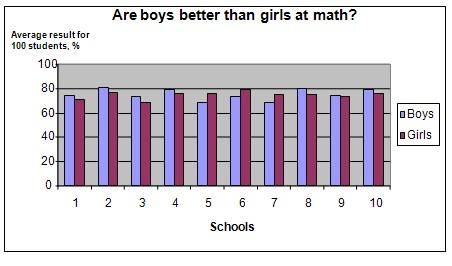| Complexity level: | 8 |
| Project cost ($): | 30 |
| Time required: | 1 day to prepare, 14 days for science project experiment |
| Material availability: | Participation of various schools. |
| Safety concerns: | None |
Hypothesis
Boys are better than girls at math.
Overview
Comparing boys and girls math performance
It has long been believed that boys perform better than girls at math. If we look around at math- related professions like engineering, physicists or mathematicians, we find more men than women in these fields.
However, it is still hot debate topic, as to whether the difference in the performance of boys and girls is due to nature or nurture. Globally, statistics tend show that boys perform better than girls at math, but if the statistics are narrowed down to countries where gender favoritism is prevalent, the gap between the performance of boys and girls becomes insignificant. This could indicate that boys are better than math in the first place, because of gender favoritism.
Nonetheless, among average quality students, boys and girls may be at par in terms of their math abilities. However, the debate still continues as to whether there is a difference, at the higher extremes of the bell curve. This is where the most talented and brilliant mathematicians are classified. Some studies show that at this end of the bell curve, boys do indeed outnumber girls.
Scientific Terms
Materials
The materials required for this science fair project:
- The math exam results of 100 boys and 100 girls age 17 years, from 10 schools
- A computer to help analyze the data
- A survey form
- Permission from the school administration to obtain and use the data
Procedure
1. For this science fair project, the independent variable is the gender of the persons who sat for the math exam. The dependent variable is their performance. This is determined by totaling the results of a hundred boys and a hundred girls respectively, from each school, and dividing by these totals by 100, to obtain the average results for both boys and girls in each school. The constants (control variables) are the age of the students and the level of difficulty of the math paper.
2. Ten secondary co-ed schools are randomly selected to take part in this survey. The co-ed schools are selected because they have both boys and girls being instructed by the same teachers and sitting for the same math exam paper.
3. Letters are delivered to the 10 selected schools to obtain their permission from their principals to have access to the math exam result of their students. It is important that you obtain sample results from different schools, in order to properly test your hypothesis.
4. Once the permission is obtained, visit the schools to gather the test result data.
5. From the information gathered, the average results for each school is calculated as follows:
Average math results for boys = (Sum of results for 100 boys)/100
Average math results for girls = (Sum of results for 100 girls)/100
6. The average math results for the boys and girls are calculated for each school and recorded in the table given below.

Results
The results show that the performance of the boys and girls did almost equally well. The boys only performed slightly better than the girls (by 0.4%).
|
Average Math’s exam results for boys and girls from 10 schools |
Average results |
||||||||||
|
1 |
2 |
3 |
4 |
5 |
6 |
7 |
8 |
9 |
10 |
||
|
Boys |
74 |
81 |
73 |
79 |
69 |
73 |
69 |
80 |
74 |
79 |
75.1 |
|
Girls |
71 |
77 |
69 |
76 |
76 |
79 |
75 |
75 |
73 |
76 |
74.7 |
The chart below represents the results of our science project experiment.

Conclusion
Our hypothesis has been proven to be false. Even though the boys did better than the girls by 0.4%, there were a few schools where the girls performed better than the boys. Overall, the difference between the boys and girls, was insignificant.
Girls tend to perform more poorly than boys in countries where gender inequality still exists. In most modern/developed countries like the USA, and in Europe,, where boys and girls are treated equally, girls perform equally well, or even better, than boys. It is believed that nurture (and not nature,) causes the difference in performance.
Also consider
This science fair project may be repeated, this time, with students from different age groups.
Modify the science project experiment, using data on math exam results for the top 10 students only, from various schools and comparing the difference in performance of the boys and girls.
References
Are boys better than girls at math? - http://www.spring.org.uk/2008/07/are-boys-better-than-girls-at-maths.php
Boys not better than girls at math – study finds - http://www.guardian.co.uk/education/2008/may/30/schools.uk1

